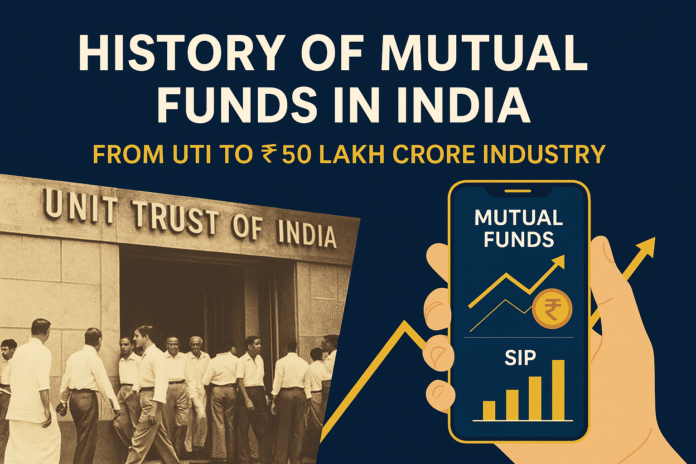
Ever wondered how mutual funds became one of India’s favorite investment choices?
Today, lakhs of Indians trust mutual funds for wealth creation, tax saving, and long-term financial planning. But this wasn’t always the case. The rise of mutual funds in India is a remarkable journey filled with innovation, reform, and transformation. In this blog post, we’ll walk through the entire History Of Mutual Funds In India — from humble beginnings to becoming a ₹50 lakh crore industry. Let’s dive into this fascinating evolution.
History Of Mutual Funds In India : Birth of Mutual Funds in India
The mutual fund industry in India began in 1963 with the establishment of the Unit Trust of India (UTI). This was a government initiative backed by the Reserve Bank of India (RBI) to channel small investors’ money into the capital markets. At a time when stock markets were considered risky and speculative, UTI became a safe, government-trusted vehicle for the masses.
- First scheme: UTI launched its first product Unit Scheme 1964 (US-64)
- Response: It became extremely popular and was considered synonymous with mutual funds in India for decades
For nearly 25 years, UTI had a monopoly in the mutual fund space.
The 1980s: Entry of Public Sector Players
Until the late 1980s, mutual funds in India meant UTI. That changed in 1987, when public sector banks were allowed to launch mutual funds.
Key entries during this era:
- SBI Mutual Fund (1987) – First non-UTI mutual fund
- Canbank Mutual Fund, Punjab National Bank Mutual Fund, LIC Mutual Fund, and Indian Bank Mutual Fund soon followed
This period marked the beginning of competition, but the industry still remained in the hands of government-owned entities.
The 1990s: Liberalization & Private Sector Entry
The economic liberalization of 1991 opened the doors to private and foreign players.
In 1993, the SEBI (Securities and Exchange Board of India) became the regulatory authority for mutual funds. This was a game-changer.
- Kothari Pioneer (now part of Franklin Templeton) became the first private mutual fund in 1993
- Soon after, foreign AMCs like Franklin Templeton, HSBC, and Fidelity entered the Indian market
- HDFC Mutual Fund, ICICI Prudential, and Birla Sun Life started operations in the mid to late 1990s
With SEBI’s regulations and private participation, the industry gained transparency, accountability, and broader investor participation.
The 2000s: Reforms, Scandals, and Consolidation
The early 2000s were a defining period. While the industry grew rapidly, it also faced challenges.
The US-64 Crisis:
- UTI’s flagship scheme US-64 collapsed in 2001 due to mismanagement and lack of transparency
- Investors suffered losses, triggering massive backlash
- The government had to bail out UTI, split it into UTI-I and UTI-II, and bring tighter reforms
Regulatory Overhaul:
- SEBI stepped in with stricter norms around disclosures, risk grading, NAV calculation, and investor protection
- Introduction of online platforms like CAMS and KARVY improved back-office efficiency
- Entry load on mutual fund purchases was abolished in 2009 to make investing more transparent
This era also saw consolidation, with weaker players exiting and stronger AMCs gaining market share.
The 2010s: Rise of Retail Investors and SIP Revolution
The mutual fund industry truly found its wings in the 2010s. Several tailwinds contributed to this boom.
Key Drivers of Growth:
- Systematic Investment Plans (SIPs) became extremely popular — especially among young, salaried investors
- Rise of digital platforms like Zerodha, Groww, and Paytm Money simplified mutual fund investing
- Massive awareness campaigns like “Mutual Funds Sahi Hai” by AMFI changed public perception
- Improved financial literacy, mobile penetration, and UPI revolution gave investors easy access
Between 2014 and 2020, mutual fund folios more than doubled. Equity mutual funds became a preferred long-term investment tool for the Indian middle class.
The Pandemic Years (2020–2021): A Test of Trust
The COVID-19 pandemic tested the resilience of mutual funds.
- Franklin Templeton India shut down six debt schemes in 2020, shaking investor confidence
- Equity markets crashed, and investors panicked — but surprisingly, many stayed invested
- SIP inflows recovered quickly and even reached record highs by mid-2021
This period proved that Indian investors had matured and begun trusting mutual funds as long-term instruments.
The 2020s and Beyond: Innovation and Inclusion
As of 2025, the mutual fund industry in India has crossed ₹50 lakh crore in assets under management (AUM).
Current Trends:
- Passive funds (index funds and ETFs) are gaining traction
- Thematic funds, international funds, and fund of funds are getting popular among savvy investors
- Direct plans with lower expense ratios are widely preferred by DIY investors
- SEBI has introduced risk-o-meters, performance disclosure norms, and cost caps for better transparency
With India’s growing middle class, digital infrastructure, and regulatory strength, mutual funds are expected to become the primary investment tool for wealth creation in the coming decade.
Timeline Snapshot: Evolution of Mutual Funds in India
| Year | Event |
|---|---|
| 1963 | UTI established (first mutual fund in India) |
| 1987 | SBI Mutual Fund launched |
| 1993 | Entry of private players; SEBI becomes regulator |
| 2001 | US-64 crisis; major reforms introduced |
| 2013 | “Mutual Funds Sahi Hai” campaign launched |
| 2020 | COVID-19, Franklin Templeton crisis |
| 2023 | Industry crosses ₹50 lakh crore AUM |
Why This History Matters to You
Understanding the journey of mutual funds helps you see:
- How far investor protection has come
- How regulations have matured
- Why mutual funds are safer and more reliable today
Whether you’re a beginner or an experienced investor, this historical context builds trust — showing that the Indian mutual fund space is now mature, well-regulated, and investor-friendly.
Frequently Asked Questions (FAQs)
Q1. When did mutual funds start in India?
Mutual funds began in India in 1963 with the launch of Unit Trust of India (UTI).
Q2. Which is the first private mutual fund in India?
Kothari Pioneer Mutual Fund, launched in 1993, was the first private mutual fund in India.
Q3. What caused the US-64 crisis?
US-64 collapsed due to poor asset allocation, lack of transparency, and mismanagement. It led to a major industry overhaul in 2001.
Q4. What is the role of SEBI in mutual funds?
SEBI regulates all mutual fund companies in India, ensuring investor protection, transparency, and compliance.
Q5. Are mutual funds safe to invest in now?
Yes, mutual funds today are highly regulated, offer transparency, and are safer than ever for long-term investors.
Disclaimer:
This article is for educational purposes only and does not constitute investment advice or recommendations. Mutual fund investments are subject to market risks. Please consult a certified financial advisor before making any investment decisions.


